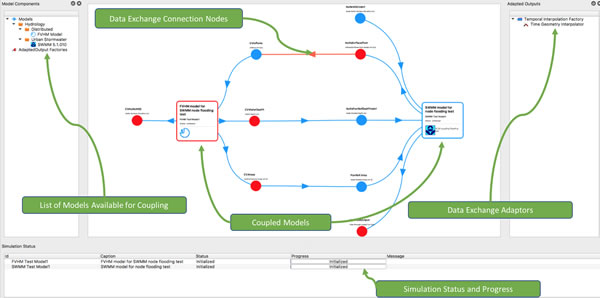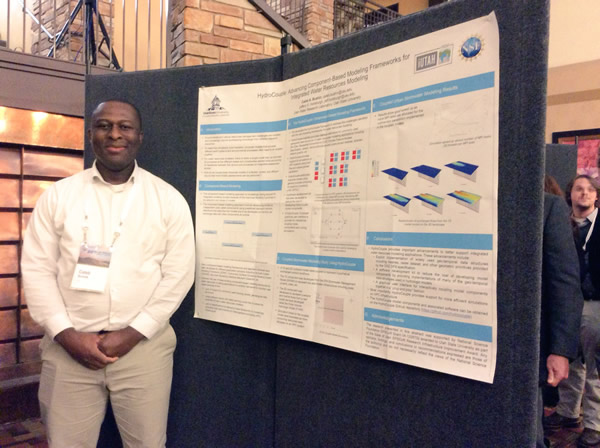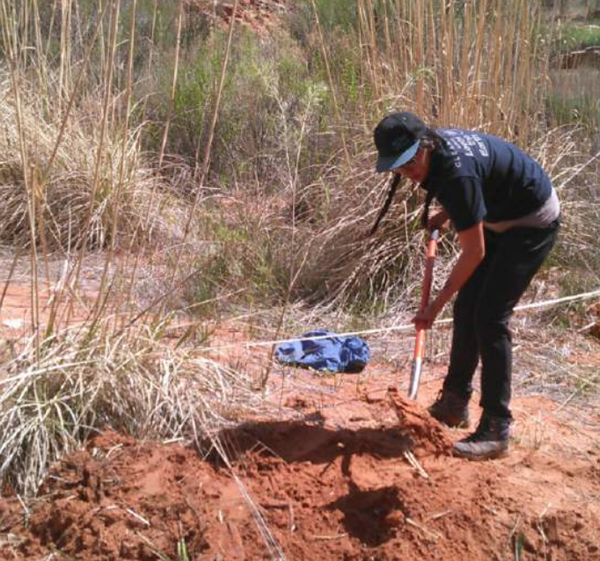Research News
November 28, 2017
In the Balance: Communication Flow
iUTAH and Utah State University researchers Bethany Neilson, an associate professor in Civil and Environmental Engineering Departments, and graduate student Julie Kelso were included in USU’s Winter 2017 alumni magazine. The article “In the Balance” features Neilson, Kelso, and other scientists, each grappling with how to adjust and mitigate water solutions for the future.
An excerpt from the story by John DeVilbiss tells of Julie’s journey from water researcher to water communicator this way. “After years of monitoring water quality on the rivers of Logan, Provo, Red Butte, and Jordan, Kelso says she now finds herself trying to communicate it to others in a meaningful way. It has been both eye opening and a bit maddening. ‘I think that’s where I get frustrated with research because, at the end of the day, it may not matter how much research you do, or answer scientific questions, if people’s values fundamentally are driving the policy-making decisions.’ So how do you communicate research to influence public values and subsequently public policy? It is a new frontier for Kelso. She is already honing her communication skills as a science reporter for Utah Public Radio. Anything to help start the conversation and bring people together. She is convinced that collaboration across universities and communities is essential if we hope to manage water more wisely.
"She thinks the biggest impact of her research with iUTAH was the way so many people came together to look at the question of water sustainability for Utah’s future. It was not just research and social scientists; they managed to get people of all labels across the state, in all different disciplines, and not just involving USU, but all three primary research institutions in the state. ‘We’re trying to get away from scientists in ivy towers working by themselves, which I think will be extremely hard to overcome,’ she says.”

November 20, 2017
Software Helps Scientists See How Nature is Connected
Caleb Buahin, a postdoctoral researcher with the iUTAH project at Utah State University, has developed a flexible software framework called HydroCouple that allows scientists to bring together models from different domains and scientific disciplines. This approach, called component-based modeling, allows for the communication and exchange of information during calculations. It allows scientists to test and refine hypotheses about how water systems behave by experimenting with different models using the same framework.
Caleb’s current work involves coupling together models that simulate the natural and built portions of urban water systems. By working with the City of Logan and using aquatic and climate data from iUTAH’s Gradients Along Mountain to Urban Transitions (GAMUT) network, he is able to examine present and future water capacity related to the cities’ stormwater system. An example output from his work shows the interactions between the canal system and the engineered stormwater infrastructure.
By demonstrating how this framework can be useful for bringing together models and data for different aspects of Utah’s water system, Caleb is creating software tools and guidance that can help other researchers evaluate not just water systems but other natural resource systems. In so doing, scientists will be able to avoid the pitfalls of studying parts of a problem independently, without considering the important ways that different resources affect each other and our future.


October 26, 2017
Saline Lakes in Dire Situation Worldwide
iUTAH researchers Sarah Null and Maura Hahnenberger, and others have contributed to an article on the “Decline of the world’s saline lakes” published online in the journal Nature Geoscience on October 23, 2017.
An announcement written by Tracy Jones for Utah State Today says that saline lakes, including Utah's Great Salt Lake, are shrinking. While the lake has risen and fallen in recent years, this particular decline represents a drop in water level, exposing more lake bed, and leading to an increase in dust. In addition to the lake’s importance to economy, wildlife, and recreation, the dust caused by this decline is hazardous to human health. Authors of the article, including scientists and water managers, say that additional water resources are needed to bring the lake back to a healthy state.
Wayne Wurtsbaugh, lead author and professor in the Department of Watershed Resources and the Ecology Center at Utah State University says that “the persistence of water diversions has decreased the lake's level about 11 feet and exposed a lot of lake bed. The state's plans to continue developing water in the basin will only worsen the problem."
"The state has had some success in water conservation for households, but since water for agriculture represents over 60% of water use, domestic conservation represents only a minor reduction," says Wurtsbaugh. "Reductions in water use from all sectors will be needed if we are to solve this problem."
Full study of the article is available below:
“Decline of the world’s saline lakes”
Authors: Wayne Wurtsbaugh, Sarah Null, Peter Wilcock and Frank Howe of Utah State University; Craig Miller of the Utah Division of Water Resources, Justin deRose of the U.S. Forest Service, Maura Hahnenberger of Salt Lake Community College, and Johnnie Moore of the University of Montana.
Press: EurekAlert! | Utah State Today | The New York Times | International Business Times | Salt Lake Tribune

October 11, 2017
iUTAH Researcher Returns to Her Roots
Ka-Voka Jackson, a former iUTAH traineeship participant, has been in the news recently for her research on invasive grass in Glen Canyon. Jackson is leading a team of researchers in a project to learn how best to eradicate invasive ravenna grass from Lake Powell's side canyons and replant with native species. She is a University of Nevada, Las Vegas graduate student in ecology and evolutionary biology, and member of the Hualapai tribe. Here is what reporter Paige Blankenbuehler had to say about Jackson in an a High Country News article dated Sept. 6, 2017:
“With the Southwest’s climate on a trajectory for prolonged drought and weather extremes, Jackson navigates the deep backcountry near Glen Canyon, around the Arizona-Utah border. Here, back home, she is working to eradicate prolific and climate-change-resistant invasives and restore native vegetation….
As part of her graduate research, in collaboration with the National Park Service and Glen Canyon National Recreation Area, Jackson is now assessing dozens of plots, 100 square meters each, in five different canyons. …In April, she took a team of technicians into the canyons to kill or pull up ravennagrass and replant native plants. Jackson is also investigating whether passive re-vegetation — allowing the native plants to come back on their own — can work. Over the course of her program, she will return to monitor her plots, recording details from each to give land managers insight into which methods could work best for Glen Canyon National Recreation Area.”
Jackson is a graduate of the University of Utah, and has a Bachelor of Science in biology with an organismal and environmental emphasis. During her time with iUTAH, she was in the iUTAH Traineeship program and worked directly with the Red Butte Creek GAMUT technicians on their research, as well as other research scientists and graduate students.
Press: High Country News | Nevada Public Radio | Salt Lake Tribune | Utah Public Radio | KJZZ Radio

October 5, 2017
Classroom Lesson Leads to Publication
Former iUTAH postdoctoral researcher Erik Oerter has collaborated with Molly Malone, Louisa Stark, and Gabriel Bowen, and others to publish the paper “Every apple has a voice” in Hydrology and Earth System Sciences, a peer-reviewed open access journal.
In the summer of 2016, Oerter served as a mentor in the Summer Research Institute (SRI), a program supported by iUTAH from 2013 – 2016. The program offered students and teachers the chance to become scientists for one week each summer. He designed a one-day water science activity for the program, including lecture, a hands-on lesson about isotopes, food sourcing, and the water cycle, and a computer lab exercise. Participants, which included high school students, undergraduate students, and high school science teachers, then turned what they learned into a poster presenting their research results.
The effectiveness of the activity was assessed through pre- and post-lesson tests, as well as participant surveys. While the lesson was effective at teaching the basics of stable isotope hydrology and the water cycle, the computer lab needed to be more specifically tailored to each participant’s abilities. Oerter felt that he learned much from the teachers while discussing his lesson. A highlight of the week was “seeing the light bulb go on” in the students as they understand complex concepts while creating their posters.
Oerter is currently working as a postdoctoral researcher at Lawrence Livermore National Laboratory in Livermore, CA. His research focuses on the intersection of hydrology and geochemistry, applying the isotope hydrology expertise gained through iUTAH to a broader set of national issues.
Originally, SRI was designed as part of CI-Water, a prior NSF EPSCoR-funded project that brought collaborating institutions in Utah and Wyoming together to address water issues in the West. Through the guidance of Director Louisa Stark and Senior Education Specialist Molly Malone from the Genetic Science Learning Center at the University of Utah, the program engaged 96 high school students and teachers, and undergraduates in 13 diverse research projects reflecting iUTAH's cross-disciplinary approach over four years.
Full study of the article is available below:
“Every apple has a voice: using stable isotopes to teach about food sourcing and the water cycle.”
Authors: Erik Oerter, Molly Malone, Annie Putman, Dina Drits-Esser, Louisa Stark, and Gabriel Bowen.
Related news article:
Collaborative Paper wins HESS Best Paper Award

Credit: Molly Malone, GSLC/University of Utah


